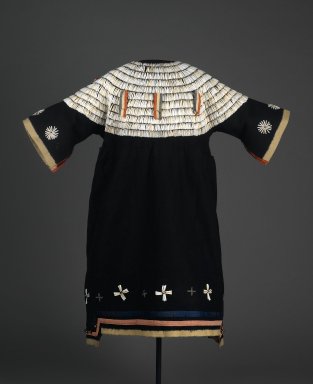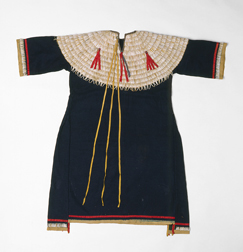A dentalium cape or dentalium dress is a garment worn by Native American women that is made from the stringing together of dentalium shells in a circular pattern around the neck and across the chest and shoulders.
The Details
Artists used dentalium shells to create dress objects, accessories, jewelry, and more. In The History of World Costume and Fashion (2011), Daniel Delis Hill defines the dentalium cape as:
“a wide collar… that covered the shoulders and upper torso similar to the ancient Egyptian pectoral. It was made of several rows of tiny dentalium shells strung together in circular bands with a hole in the center for the head.” (308)
This 1875-1900 dress (Fig. 1), possibly of Sioux origin, at the Brooklyn Museum has rows of dentalium shells strung together to hang over the shoulders. In addition to the shells, the cape is also decorated with ribbons, beads, and bells.
In his essay “Native North American Art” (2018), curator and scholar Dr. Paul Apodaca describes dentalium shells:
“Small marine mollusks with a hard white surface, dentalium shells are found along the West coast and traded as far as the Atlantic coast. They were greatly prized by the Plains tribes who used them to lavishly decorate clothing, especially women’s, and strung them together as necklaces, full-length ornaments, and breastplates.”
The existence of dentalium shells in garments made in the Plains is proof of trade between groups along the coasts and groups further inland. A smaller dentalium cape, shown in figure 2, was made to be worn by a young girl. It was made in ca. 1865 in the Eastern Plains, and it is embellished with ribbons to further decorate the garment.
Dentalium shells were a very highly valued material throughout groups in the Plains region. In addition to making accessories and jewelry, the shells were often used as a form of currency in trading. Therefore, a dress as highly adorned as the one featured in figure 3 would most likely be worn by a woman of high wealth and status, due to the value of the materials as well as the time and skill needed to construct such a garment.
In The Berg Encyclopedia of World Dress and Fashion (2010), Adriana Greci Green discusses types of decoration used to adorn clothing employed by indigenous groups in the Plains region:
“The two principal types of decoration of cloth dresses consisted of elk teeth and dentalium shells. The latter was a particularly popular style among the Lakota between 1890 and 1900. The shells were sewn in concentric parallel rows (about ten) circling out from the neck and completely covering the upper portion of the dress, to a stunning effect. The bottom portion of the dress was trimmed with colored ribbons, sequins, and more shells.” (Green 437-446)
This velvet dress (Fig. 4) is from the Northern Plains and contains rows of dentalium shells around the collar. It also has trimming details on the edge of the sleeves and bottom of the garment.
The woman in figure 5, known as Mrs. Chips, was photographed between 1887 and 1899 wearing her dentalium cape. Her dress exemplifies the description offered above by Green, displaying the concentric circles in which the dentalium shells were stitched onto the fabric.
Dentalium shells were a very important material to many Native American groups who used it not only to embellish capes, but also for jewelry, decoration, and even currency.
Fig. 1 - Artist unknown (Possibly Sioux). Dress, 1875-1900. Wool cloth, dentalium shells, ribbon, glass beads, brass bells, cotton; 110 x 85 cm (43 5/16 x 33 7/16 in). New York: Brooklyn Museum, 46.96.12. Charles Stewart Smith Memorial Fund. Source: Brooklyn Museum
Fig. 2 - Artist unknown (Sisitonwan Dakota (Sisseton Sioux)). Girl's cape/overblouse, 1865. Dentalium shell/shells. New York: National Museum of the American Indian, 3/6818. Source: National Museum of the American Indian
Fig. 3 - Artist unknown (Sioux, Native American). Dress, 19th or 20th century. Blue tradecloth, dentalium shells, and silk ribbon; 124.5 cm (49 in). Detroit: Detroit Institute of Arts, 1994.100. Founders Society Purchase, Clarence E. Wilcox Fund. Source: Detroit Institute of Arts
Fig. 4 - Artist unknown (probably Northern Plains). Girl's dress, 1878. Velvet, dentalium shell/shells, hide thong/babiche; 71 x 64 cm (27 15/16 x 25 3/16 in). New York: National Museum of the American Indian, 19/720. Source: National Museum of the American Indian
Fig. 5 - Horace G. Jennerson (American). Mrs. Chips (possibly Oglala Sioux), ca. 1887-1899. Glass plate negative. New York: National Museum of the American Indian. Source: National Museum of the American Indian
References:
- Apodoca, Paul. “Native North American Art.” Grove Art Online, 2003. https://doi-org.libproxy.fitsuny.edu/10.1093/gao/9781884446054.article.T061112
- Green, Adriana Greci. “The Plains.” Berg Encyclopedia of World Dress and Fashion: The United States and Canada. Oxford: Bloomsbury Academic, 2010. http://www.worldcat.org/oclc/1176307918
- Hill, Daniel Delis. The History of World Costume and Fashion. Prentice Hall, 2011. http://www.worldcat.org/oclc/768100950.















